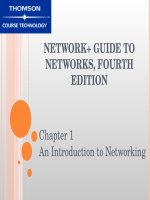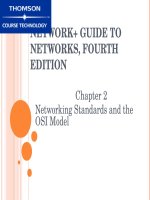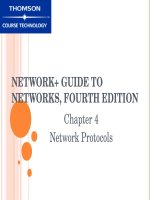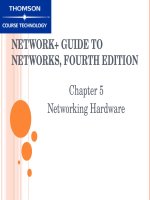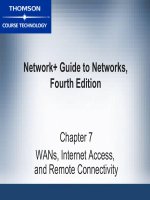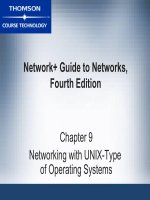NETWORK+ GUIDE TO NETWORKS, FOURTH EDITION - CHAPTER 7 ppt
Bạn đang xem bản rút gọn của tài liệu. Xem và tải ngay bản đầy đủ của tài liệu tại đây (982.65 KB, 56 trang )
Network+ Guide to Networks,
Fourth Edition
Chapter 7
WANs, Internet Access,
and Remote Connectivity
Objectives
• Identify a variety of uses for WANs
• Explain different WAN topologies, including their advantages
and disadvantages
• Describe different WAN transmission and connection
methods, including PSTN, ISDN,
T-carriers, DSL, broadband cable, SONET, and wireless
Internet access technologies
• Compare the characteristics of WAN technologies, including
throughput, security, and reliability
• Describe the software and hardware requirements for
remotely connecting to a network
Network+ Guide to Networks, 4e
2
WAN Essentials
• Internet is largest WAN in existence
– Most WANs arise from need to connect buildings
• WANs and LANs similar in fundamental ways
– Differ at Layers 1 and 2 of OSI Model
• WANs typically send data over publicly available
communications networks
– Network service providers (NSPs)
– Dedicated lines
• WAN link: connection between WAN sites (points)
Network+ Guide to Networks, 4e
3
WAN Essentials (continued)
Figure 7-1: Differences in LAN and WAN connectivity
Network+ Guide to Networks, 4e
4
WAN Topologies
• WAN topologies resemble LAN topologies
– Details differ because of:
• Distance they must cover
• Larger number of users
• Heavy traffic
• WAN topologies connect sites via dedicated and, usually,
high-speed links
– Requires special equipment
– Links not capable of carrying nonroutable protocols
Network+ Guide to Networks, 4e
5
WAN Topologies (continued)
• Bus
– Similar to bus LAN topology
– Often best option for organizations with few sites
and capability to use dedicated circuits
– Dedicated circuits make it possible to transmit data
regularly and reliably
• Ring
– Similar to ring LAN topology
– Usually use two parallel paths for data
• Cannot be taken down by loss of one site
– Only practical for connecting few locations
Network+ Guide to Networks, 4e
6
WAN Topologies (continued)
Figure 7-2: A bus topology WAN
Network+ Guide to Networks, 4e
7
WAN Topologies (continued)
Figure 7-3: A ring topology WAN
Network+ Guide to Networks, 4e
8
WAN Topologies (continued)
• Star
– Separate routes for data between any two sites
– Failure at central connection can bring down WAN
• Mesh
– Every site interconnected
• Fault-tolerant
– Full mesh WAN and partial mesh WAN
• Tiered
– Sites connected in star or ring formations
interconnected at different levels
– Highly flexible and practical
Network+ Guide to Networks, 4e
9
WAN Topologies (continued)
Figure 7-4: A star topology WAN
Network+ Guide to Networks, 4e
10
WAN Topologies (continued)
Figure 7-5: Full mesh and partial mesh WANs
Network+ Guide to Networks, 4e
11
WAN Topologies (continued)
Figure 7-6: A tiered topology WAN
Network+ Guide to Networks, 4e
12
PSTN
• Public Switched Telephone Network (PSTN) comprises
entire telephone system
– Traffic carried by fiber-optic and copper twisted-pair
cable, microwave, and satellite connection
• Dial-up usually means connection using PSTN line
• Advantages: Ubiquity, ease of use, low cost
• Disadvantages: Low throughput, quality, marginal security
Network+ Guide to Networks, 4e
13
PSTN (continued)
Figure 7-7: Local loop portion of the PSTN
Network+ Guide to Networks, 4e
14
PSTN (continued)
Figure 7-8: A long-distance dial-up connection
Network+ Guide to Networks, 4e
15
X.25 and Frame Relay
• X.25: analog, packet-switched technology designed for longdistance data transmission
– Specifies Physical, Data Link, Network layer
protocols
– Excellent flow control
– Ensures data reliability over long distances
– Comparatively slow
• Frame Relay: updated, digital version of X.25
– Does not guarantee reliable delivery of data
• Leaves error correction for higher-layer protocols
Network+ Guide to Networks, 4e
16
X.25 and Frame Relay (continued)
• Switched virtual circuits (SVCs): connections established
when parties need to transmit, then terminated after
transmission complete
• Permanent virtual circuits (PVCs): connections established
before data needs to be transmitted and maintained after
transmission complete
– Not dedicated, individual links
• Committed information rate (CIR): minimum bandwidth
guaranteed by service provider
• With Frame Relay, pay only for bandwidth required
– Throughput sensitive to network traffic
Network+ Guide to Networks, 4e
17
X.25 and Frame Relay (continued)
Figure 7-9: A WAN using frame relay
Network+ Guide to Networks, 4e
18
ISDN
• International standard for transmitting digital data over PSTN
– Specifies protocols at Physical, Data Link, Transport
layers
• Handle signaling, framing, connection setup and
termination, routing, flow control, error detection
and correction
– Dial-up or dedicated connections
– Carries voice calls and data simultaneously on
one line
• B channel and D channel
Network+ Guide to Networks, 4e
19
ISDN (continued)
Figure 7-10: A Basic Rate Interface (BRI) link
Figure 7-11: A Primary Rate Interface (PRI) link
Network+ Guide to Networks, 4e
20
T-Carriers
• Standards specify method of signaling
– Belong to Physical layer
– Use time division multiplexing (TDM) over two wire
pairs
• Divide single channel into multiple channels
Network+ Guide to Networks, 4e
21
Types of T-Carriers
Table 7-1: Carrier specifications
Network+ Guide to Networks, 4e
22
T-Carrier Connectivity
• Lines require connectivity hardware at customer site and
local telecommunications provider’s switching facility
• Wiring:
– UTP, STP, coaxial cable, microwave, or fiber-optic
• STP preferable to UTP (repeaters generally required)
• For multiple T1s, coaxial, microwave, or fiber-optic
required
• For T3s, microwave or fiber-optic necessary
Network+ Guide to Networks, 4e
23
T-Carrier Connectivity (continued)
• Channel Service Unit/Data Service Unit (CSU/DSU):
– Connection point for T1 line at customer’s site
– CSU provides termination for digital signal
• Ensures connection integrity through error correction
and line monitoring
– DSU converts T-carrier frames into frames LAN can
interpret and vice versa
• Connects T-carrier lines with terminating equipment
• Terminal equipment: Switches, routers, or bridges (may be
integrated with CSU/DSU)
Network+ Guide to Networks, 4e
24
T-Carrier Connectivity (continued)
Figure 7-13: A T-carrier connection to a LAN through a router
Network+ Guide to Networks, 4e
25
